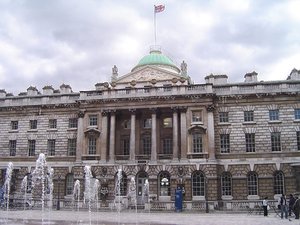Somerset House
|
|
Somerset House is a large building situated on the south side of The Strand in central London, overlooking the River Thames, just east of Waterloo Bridge. The central block of the Neoclassical building, the outstanding project of the architect Sir William Chambers, dates from 1776–1796. It was extended by respectfully classical Victorian wings to north and south. A building of the same name was first built on the site more than two centuries earlier.
| Contents |
Early history
Somerset_House_by_Kip_1722.JPG
Somerset House takes its name from the London home of Edward Seymour, Duke of Somerset, who commissioned a riverside mansion on the site in 1547, one of a row of noblemen's houses with fronts along the Strand. The building was constructed from stone removed from some of the chantries and cloisters at St. Paul's Cathedral which were demolished at the behest of Somerset and other leading Protestant nobles as part of the ongoing Dissolution of the Monasteries.
When Somerset fell from grace in 1551 (being executed for treason the following year), the building passed to the Crown and was used by Princess Elizabeth for some years before she was crowned Queen Elizabeth I in 1558.
During the reign of King King James I, the building became the London residence of his wife Anne of Denmark, was renamed "Denmark House". She commissioned a number of expensive additions and improvements, some to designs by Inigo Jones. This expansion of the building continued during Charles I's reign, including the then highly controversial addition by his wife, Henrietta Maria, of a Roman Catholic chapel (also designed by Jones – who was later to die at Somerset House, in 1652).
After the English Civil War and the Restoration, Somerset House once again became a royal residence, and was refurbished by Sir Christopher Wren in 1685. During the 18th century, however, the building ceased its royal associations. Though the view from its terraced riverfront garden, open to the public, was painted twice on his London visit by Canaletto (looking upriver and down), it was used for storage, as a residence for visiting overseas dignatories and as a barracks for troops, but suffered from neglect and demolition began in 1775.
Current building
Somerset.house.arp.750pix.jpg
Sir William Chambers, the premier British architect of his day (though his modern reputation is outshone by his less conservative rival Robert Adam), spent the last two decades of his life in several campaigns of building at the new (present) Somerset House. It was completed after his death by James Wyatt.
It was intended to house various learned societies, including the Royal Academy, which Chambers had been instrumental in founding, and which had been among the last tenants of the previous building. Various government departments found quarers at Somerset House, and as these needed expanded space, the wings were added, first by Sir Robert Smirke in the 1830s and then by Sir James Pennethorne, the West Wing being completed in 1856. Somerset House now presents more of the aspect of a terrace than Chambers would have intended.
Thomas Telford, then a stone mason, but later an eminent civil engineer, was among those who worked on its construction.
Government use
Somerset House has been used by the Inland Revenue since it was created by a merger of the Stamp and Taxes Offices and the Excise Department in 1849. The Revenue's head office now occupies the east, west and new wings. Other government offices originally housed in the building included the Navy Board. Somerset House became particularly well-known during the 20th century as the location of family records, the General Register Office holding copies of all Birth, Marriage and Deaths certificates in England and Wales. Indexes to these are now at the Family Records Centre. In 2004, it was proposed that the Supreme Court of the United Kingdom be housed in the so-called "new" wing (ie the one completed in 1856), but a decision has now been made to use Middlesex Guildhall instead.
A home for arts and learning
Somerset_ice_rink_IceRink1_dafyyd_jones.jpg
As well as the Royal Academy, Somerset House was fitted out to house the Royal Society and the Society of Antiquaries. These, and the Geological Society, moved to Burlington House in Piccadilly in the early 19th century.
In the late 20th century the building was reinvigorated as a centre for the visual arts. The first new institution to move in was the Courtauld Institute of Art, including the Courtauld Gallery, which has an important collection of old master and impressionist paintings. In the late 1990s the main courtyard ceased to be a civil service carpark, and the main terrace overlooking the Thames was refurbished and opened to the public. A new visitor centre featuring audiovisual displays on the history of the building; the gilded Lord Mayor of London's state barge; and a shop and cafe was opened in the wing overlooking the river. The the Gilbert Collection of decorative arts, and the Hermitage Rooms, which stage exhibitions of items loaned from the Hermitage Museum in St Petersburg, moved into the same wing.
In the winter its central courtyard is home to an open air ice rink.
External links
- Somerset House's homepage (http://www.somerset-house.org.uk/index.html)

